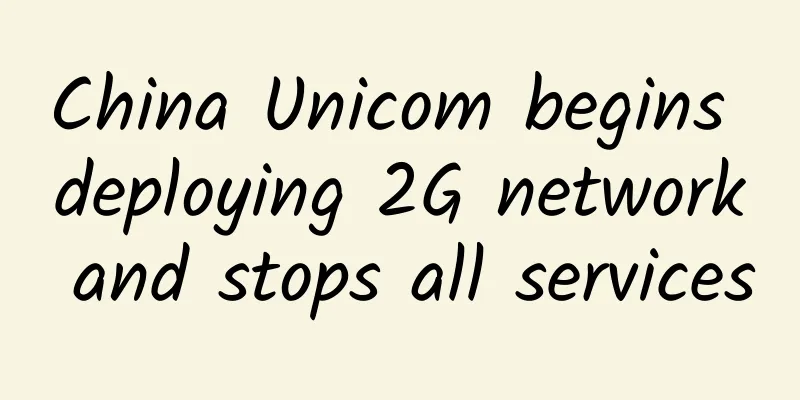China Unicom begins deploying 2G network and stops all services

|
2G outdated communication technology will inevitably become history, but no one expected that this day would come so soon. According to documents leaked from China Unicom, many provinces of China Unicom have begun to actively deploy the decommissioning of 2G networks and require market lines to strictly prohibit the development of 2G business. Recently, China Unicom has been actively deploying the 2G network decommissioning work in many provinces, and has required the market lines to strictly prohibit the development of 2G business. According to internal information, China Unicom's 2G customers currently account for about 2% of the total number of customers. At the end of 2017, the number of China Unicom users reached 280 million, and the current number of 2G customers is about 5 million. This means that once China Unicom's 2G is fully decommissioned, 5 million users will not be able to make calls. Looking around the world, in fact, operators have already started to withdraw from 2G networks. Starting from July 1, 2017, the 2G communication network in Taiwan, China, will be terminated. Customers using 2G networks can no longer make any calls or conversations (except emergency calls), send or receive text messages, or use their data services, and their phone numbers will be retained until the end of December this year. At the same time, operators in Taiwan, such as Chunghwa Telecom, Big Mobile, and Far EasTone Telecommunications, have attracted 2G users to migrate through preferential tariff plans. In 2017, there were many incidents of shutting down 2G networks:
In fact, before this series of 2G shutdowns, more than a dozen operators around the world had stopped 2G network services. 2G communications are slowly fading from the stage of history. Seeing so many operators shut down their 2G networks, people are also concerned about when China's telecom operators will shut down 2G. However, none of the three operators, China Mobile, China Telecom and China Unicom, have announced a timetable. Now it seems that the time for 2G network withdrawal is not ripe, and even if operators are willing to give up, they will face many difficulties. The first difficulty is that the existing 2G user groups of these three operators are really too large, beyond the imagination of many people. For our operators, if they want to shut down the 2G network, the premise is to reduce the number of 2G users to the maximum value, but it is very difficult to do so at present. If the 2G user ratio is 2% as the threshold for starting to shut down the 2G network, it is optimistically estimated that it will take about three years before the right time to withdraw from the network is here. Another important factor is that operators must prepare for the 2G network withdrawal, and the most important thing is voice services. Voice services are the most basic communication needs, and users are very sensitive to them. The feeling of not being able to make a call once or twice and not being able to access the Internet once or twice is completely different for users. If operators push forward the 2G network withdrawal without making preparations, it will undoubtedly be a disaster and self-destructive. According to the current thinking of operators, 4G LTE network can carry voice services through VoLTE technology. Therefore, one of the prerequisites for 2G network withdrawal is that VoLTE is mature enough to provide users with voice call experience that is no less than that of 2G network. However, at present, our operators still have a lot of work to do in this regard, including the network side and the terminal side, and need to promote the popularization of VoLTE terminals as soon as possible. But then again, the most difficult part of 2G network withdrawal is the users themselves. This inevitably reminds us of the embarrassment and difficulty of the withdrawal of Xiaolingtong. Although the Xiaolingtong technology itself has been eliminated, there are still some users who would rather keep it and refuse to let go. I believe that when 2G is withdrawn from the network, operators will also encounter this situation, and it will not be an isolated phenomenon. Therefore, the competent authorities and operators should prepare for the rainy day, do a good job of guidance, promote the upgrading of my country's communication technology, and let users enjoy better communication services. Current status of China Unicom's 2G network decommissioning: Last year, some provinces began to gradually shut down the 2G network, and all major business halls posted notices of 2G network decommissioning. In order to further improve the service level, China Unicom will transform and upgrade the 2G network (decommission the 2G network), and recommends customers to use 3G or 4G mobile terminals. As early as the beginning of 2017, the number of 2G network base stations offline in some provinces exceeded 100, and many places could no longer receive China Unicom's 2G signals. China Unicom has also been guiding users to replace 3G/4G mobile phones to avoid being unable to make calls due to 2G network offline. Reasons for withdrawal: Currently, the three major operators, China Mobile, China Telecom and China Unicom, all have 2G, 3G and 4G networks, which have huge maintenance costs. Most 2G users are elderly people, and their contribution to the operators' revenue is relatively low, and they are basically operating at a loss. By 2020, the three major operators will fully popularize 5G networks, and by then they will need to maintain four communication networks at the same time, and the maintenance costs will further increase. For operators, the 2G network will become a chicken rib, which is why it is not difficult to understand why China Unicom deployed the 2G network for withdrawal. Especially now that China Unicom has undergone mixed reform, Internet capital has settled in and has placed greater emphasis on the investment return ratio. At present, China Unicom's application for 2G withdrawal has been approved by the Ministry of Industry and Information Technology. Preparation for decommissioning: Every time the network is upgraded, the customer's mobile phone must also be upgraded. We need to use 3G mobile phones to receive 3G signals and 4G mobile phones to receive 4G signals. Of course, when 5G arrives, we need to replace 5G mobile phones to use the 5G network. After the network upgrade, the three major operators, China Mobile, China Unicom and China Telecom, first vigorously promote the new version of mobile phones and guide users of old versions to replace their mobile phones, while prohibiting the market from developing old versions of mobile phones. China Unicom also did a lot of related work before the offline 2G network. China Mobile has also been considering shutting down its 2G network, but due to the large number of 2G users, it has not yet implemented a 2G shutdown plan. I hope China Unicom can control the pace of 2G shutdown and not hurt the hearts of old users. |
<<: The difference between hybrid WAN and SD-WAN
Recommend
Understanding Ethernet Switching Technology in One Article
Labs Guide Currently, most campus networks are ne...
[Black Friday] ITLDC: 40% off unlimited traffic VPS annual payment, 25% off dedicated server, 14 data centers in the United States/Singapore/Netherlands
ITLDC's Black Friday promotion this year last...
[11.11] UFOVPS 30% off, top up 200 yuan and get 20 yuan, Japan/Hong Kong CN2 GIA/US high defense optional
UFOVPS has launched a promotion during the Double...
South Korean operator SKT invests $100 million in OpenAI competitor to develop large-scale AI models for the telecommunications industry
The trend of big AI models has reached the teleco...
Actual combat case: Explosion! Accessing a certain IP in the intranet caused the entire network loop to crash. The root cause was this lazy configuration...
Background The client company is a retail company...
LOCVPS Hong Kong Cloud/Confederation bandwidth upgrade is free of charge, top up 350 yuan and get 50 yuan, 20% off for the whole site
LOCVPS is a long-established Chinese VPS service ...
United Nations: Food crisis is approaching China: Smart agriculture can protect against the crisis
Entering 2020, the term "food crisis" s...
To lead the high-quality development of information technology innovation, the Shenzhou Cloud Technology National Tour is officially launched!
On March 2, 2023, the Shenzhou Cloud Technology N...
Why consider 800G now?
Increased demand for home offices, streaming serv...
2G is shut down in many places. How can NB-IoT and Cat.1 seize the opportunity in the reshuffle?
It's the start of the new school year again, ...
Let you understand the MQTT protocol
Author: Wang Yingyue, Unit: China Mobile Smart Ho...
Internet of Things Development Trend 4 (2019)
Continued from the previous article: "The De...
Gartner: China's IT spending is expected to exceed US$550 million in 2022
According to Gartner's latest forecast, globa...
How to implement a 100-channel network camera monitoring solution?
1. Calculate line bandwidth First, we need to det...



![[Black Friday] RackNerd: 9 data centers in San Jose/Seattle, KVM architecture, starting at $8.89 per year](/upload/images/67cac4933fb0d.webp)





